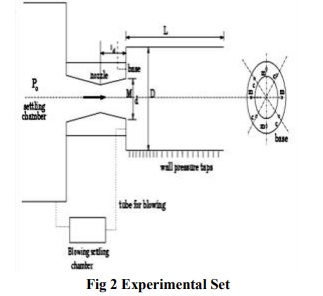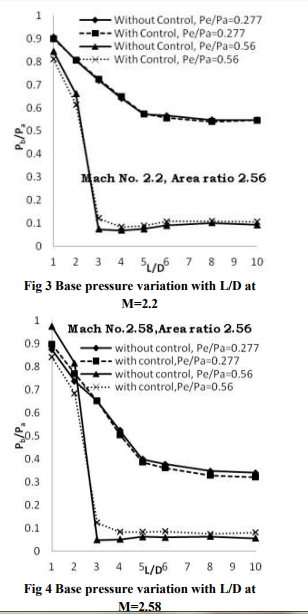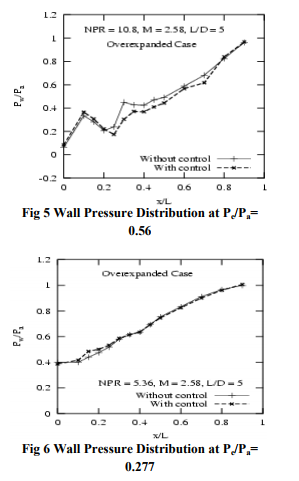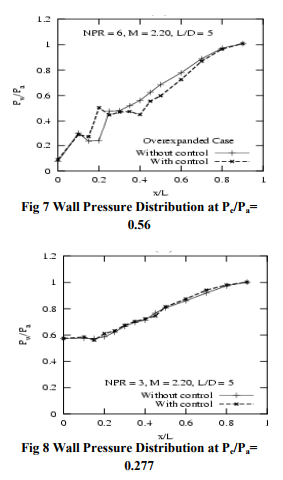IJCRR - 4(11), June, 2012
Pages: 108-114
Date of Publication: 18-Jun-2012
Print Article
Download XML Download PDF
BASE PRESSURE STUDIES FROM OVER EXPANDED NOZZLE FOR AREA RATIO 2.56
Author: Maughal Ahmed Ali Baig, Sher Afghan Khan, E. Rathakrishnan
Category: Technology
Abstract:The present paper aims at study of variations in base pressure at different levels of over expansion of jet
in a suddenly expanded axi-symmetric duct. The results of an experimental investigation carried out at
two different fixed levels of Over Expansion namely 0.277 and 0.56 are compared. The area ratio of the
present study is 2.56. The jet Mach numbers at the entry to the suddenly expanded duct, studied are 2.2
and 2.58. The length-to-diameter ratio of the suddenly expanded duct is varied from 10 to 1. Active control in the form of four micro jets of 1mm orifice diameter located at 900 intervals along a pitch circle
diameter of 1.3 times the nozzle exit diameter in the base region are employed. In addition to base pressure, wall pressure field along the duct is also studied. From the present studies it is found that at a
high level of over expansion micro jets are marginally effective. It is also found from wall pressure studies that the micro jets do not disturb the flow field in the enlarged duct.
Keywords: Axi Symmetric duct, Micro jets, Base Pressure, Mach number, L/D Ratio
Full Text:
INTRODUCTION
Flow separation at the base of aerodynamic vehicles such as missiles, rockets, and projectiles leads to the formation of a lowpressure recirculation region near the base. The pressure in this region is generally significantly lower than the free stream atmospheric pressure. Base drag, caused by this difference in pressures, can be up to two-thirds of the total drag on a body of revolution at Transonic Mach numbers. However, the base drag will decrease at Supersonic speeds and is around one-third of the total drag. Whereas, the base drag is 10 per cent of the skin-friction drag in the sub-sonic flow as the wave drag will not be there. Techniques such as base burning and base bleed have been used traditionally to reduce base drag. However, very few studies have been carried with active control. Here an attempt has been made to study the problem with an internal flow. The experimental study of an internal flow apparatus has a number of distinct advantages over usual ballistics test procedures. Huge volume of air supply is required for tunnels with test-section large enough so that wall interference will not disturb flow over the model. `Stings' and other support mechanism required for external flow tests are also eliminated in the internal flows. The most important advantage of an internal flow apparatus is that complete static pressure and surface temperature measurements can be made not only along the entrance section to the expansion(analogous to a body of the projectile) but also in the wake region.

LITERATURE REVIEW
Anderson and Williams [1] worked on base pressure and noise produced by the abrupt expansion of air in a cylindrical duct. With an attached flow the base pressure was having minimum value which depends mainly on the duct to nozzle area ratio and on the geometry of the nozzle. The plot of overall noise showed a minimum at a jet pressure approximately equal to that required to produce minimum base pressure. Srikanth and Rathakrishnan [2] developed an empirical relation for base pressure as a function of nozzle pressure ratio, area ratio and length-to-diameter ratio of the enlarged duct. Rathakrishnan et. al [3] studied the influence of cavities on suddenly expanded subsonic flow field. They concluded that the smoothening effect by the cavities on the main flow field in the enlarged duct was well pronounced for large ducts and the cavity aspect ratio had significant effect on the flow field as well as on the base pressure. They studied air flow through a convergent axi-symmetric nozzle expanding suddenly into an annular parallel shroud with annular cavities experimentally. From their results it is seen that increase in aspect ratio from 2 to 3 results in decrease in base pressure but for increase in aspect ratio from 3 to 4, the base pressure goes up. Rathakrishnan [4] investigated the effect of Ribs on suddenly expanded axi-symmetric flows laying emphasis on the base pressure reduction and enlarged duct pressure field. Annular ribs with aspect ratio 3:1 was found to be the optimum and they do not introduce any oscillations to the wall pressure field of the enlarged duct, at the same time the increase in pressure loss compared to plain was also less than six per cent. Even for the case with passive control the duct L/D in the range 3 to 5 experiences the minimum base pressure, as in the case of plain ducts. Khan and Rathakrishnan [5] studied the control of suddenly expanded flow from over expanded nozzles with micro jets for high supersonic Mach number. The aim of their study was to access the effectiveness of the micro jets under the influence of adverse pressure gradient. Khan and Rathakrishnan [6] conducted the experiments for under expanded case for Mach numbers 1.25, 1.3, 1.48, 1.6, 1.8, 2.0. All the experiments were conducted for a fixed value of level of under expansion (Pe /Pa = 1.5). They found from their studies that the micro jets are very effective whenever nozzles are under expanded. Khan and Rathakrishnan [7] studied the control of suddenly expanded flows for correctly expanded case. They found from their studies that the micro jets are not very effective for correctly expanded case for Mach numbers 1.25, 1.3, 1.48, 1.6, 1.8, 2.0. There is a marginal change in the values of the base pressure. Another important phenomenon observed was that even for the correctly expanded flow case the flow is dominated by the waves. Earlier it was believed that the correctly expanded flow is free from waves. The effect of level of expansion in a suddenly expanded flow and the control effectiveness has been reported by Khan and Rathakrishnan [8]. In their study they considered correct, under, and over expanded nozzles for four area ratio for the Mach numbers 1.25, 1.3, 1.48, 1.6, 1.8, 2.0, 2.5, and 3.0. They conducted the tests for the NPRs in the range 3 to 11. From their results it was found that for a given Mach number, length-to-diameter ratio, and the nozzle pressure ratio the value of base pressure increases with the area ratio. This increase in base pressure is attributed to the relief available to the flow due to increase in the area ratio. Pandey and Kumar [10] studied the flow through nozzle in sudden expansion for area ratio 2.89 at Mach 2.4 using fuzzy set theory. From their analysis it was observed that L/D = 4 is sufficient for smooth development of flow keeping in view all the three parameters like base pressure, wall static pressure and total pressure loss. The above review reveals that even though there is a large quantum of literature available on the problem of sudden expansion, vast majority of them are studies without control. Even among the available literature on investigation of base flows with control, most of them, use only passive control by means of grooves, cavities and ribs. Only very few studies report base flow investigation with active control. Therefore, a closer look at the effectiveness of active control of base flows with micro-jets, especially in the supersonic flow regime will be of high value, since such flow field finds application in many problems of applied gas dynamics, such as the base drag reduction for missiles and launch vehicles, base heating control for launch vehicles, etc. With this aim the present work investigates the base pressure control with active control in the form of micro jets.
EXPERIMENTAL SETUP
The experiments were carried out using the experimental facility at the High Speed Aerodynamics Laboratory (HSAL), IIT, Kanpur. Fig. 2 shows the experimental setup used for the present study. At the exit periphery of the nozzle there are eight holes as shown in the figure, four of which (marked c) were used for blowing and the remaining four (marked m) were used for base pressure (Pb) measurement. Control of the base pressure was done, by blowing through the control holes (c), using the pressure from the blowing chamber by employing a tube connecting the chamber and the control holes (c). Pressure taps are provided on the enlarged duct wall to measure wall pressure distribution in the duct. First nine holes are made at an interval of 4 mm each and remaining is made at an interval of 8 mm each.

RESULTS AND DISCUSSION
The measured data consists of the base pressure (Pb), wall static pressure (Pw) distribution along the length of enlarged duct and nozzle pressure ratio (NPR) defined as the ratio of stagnation pressure (P0) to back pressure (Patm). All measured pressures were non-dimensionalized with the ambient atmospheric pressure (i.e. back pressure). In addition to the above pressures, other parameters of the present study are the jet Mach number (M), area ratio and L/D ratio of the enlarged duct and fixed level of over expansions. Area ratio discussed in this paper is 2.56 and the control pressure ratio is same as the main settling chamber pressure ratio. This investigation focuses attention mainly on the effect of level of over expansion of 0.277 and 0.56 (i.e. Pe /Pa=0.277 and 0.56) and the effectiveness of active control in the form of micro-jets, located at the base region of suddenly expanded axi-symmetric ducts, to modify the base pressure for Mach 2.2 and 2.58. Figure 3 presents result for Mach No. 2.2. It is seen that the base pressure is insensitive to L/D and also assumes high values (i.e. low suction). As the level of over expansion decreases the base suction decreases and base pressure continues to decrease with L/D and attains a minimum at L/D = 6 for Pe /Pa =0.277 and it is L/D= 3 for Pe /Pa =0.56. The base pressure minimum at L/D = 6 is in agreement with the results of Rathakrishnan and Sreekanth [2], for subsonic and transonic flow. The control is only of marginal influence on the base pressure for all values of L/D for highest level of over expansion. Further, it is seen that when the level of over expansion decreases the trend is different, control results in decrease of base pressure. It becomes independent of L/D for L/D > 3. It is seen that, when the micro jets are activated the base pressure assumes considerably lower values compared to the corresponding cases without micro jets. It is evident from these results that, for Pe /Pa = 0.277 the control effectiveness is strongly influenced by the jet Mach number. The effectiveness increases with increase of Mach number. Also, the effectiveness is significant for L/D ranging from 3 to 6 compared to L/D range 6 to 10.

Figure 4 presents results for Mach number = 2.58. It is seen from the figure that there is slightly different behaviour compared to the behaviour at M = 2.2. Even for the lowest level of expansion the base pressure comes down with increase of L/D, showing a minimum at L/D = 6 for Pe /Pa =0.277 and it is L/D= 4 for Pe /Pa =0.56. The tendency of base pressure coming down with L/D becomes significant as the level of over expansion decreases. Here again the control is of marginal effect on base pressure. Further, like M = 2.2, for M = 2.58 also L/D more than 6 does not influence the base pressure significantly. However, at Mach 2.58 the control is more effective compare to at Mach 2.2. It is seen that for same level of overexpansion, for a given area ratio, the reattachment length for higher Mach number will be higher. This will dictate base vortex strength. If the reattachment length is such that the vortex can be strong, this will result in large suction. From the above results it is found that these conditions are satisfied for Mach 2.2 and 2.58 for all level of expansion. Further, it is evident that, Pb/Pa is the lowest for Mach number 2.58 at the expansion level of 0.277. It decreases with decrease of level of expansion. When the micro jets are on, they entrain the mass from their vicinity. It should be noted that, the level of pressure at the base region depends on the shock strength at the nozzle exit for the present case of over expanded jets. However, it is the combined effect of jet Mach number, the shock strength and the location of the micro-jets, which will fix the base pressure level. In the present study the location of the micro-jets are fixed. Therefore, for low values of area ratio the micro jets are close to the base corner and away from the base corner for higher area ratios. Hence, for lower area ratio the micro jets will counter the shock effect which tends to increase the base pressure more effectively than for higher area ratio. Hence, the vortex at the base will be in a position to create more suction at the base for lower area ratio compared to higher area ratio. This appears to be the cause for the control to become more effective at Mach 2.58 than Mach 2.2. Measurement of wall static pressure along the enlarged duct can be one of the best possible ways to understand one of the major problems associated with base flows i.e. Oscillatory nature of pressure field in the enlarged duct just downstream of the base region. To study this wall pressure distribution, tests are conducted with and without controls. Fig 5 and Fig 7 indicate the behaviour of wall pressure at over expansion level of 0.56 for Mach 2.58 and Mach 2.2 respectively and Fig 6 and Fig 8 indicate the behaviour of wall pressure at high level of over expansion i.e. 0.277. It can be observed that the control is more effective at lower level of expansion, i.e. at Pe /Pa =0.56 than at Pe /Pa=0.277.


CONCLUSION
It is evident that, Mach 2.58 influences the base pressure more than the lower Mach numbers. Also, at Mach 2.58, the micro jets have a powerful influence on base pressure, taking its value to low levels compared to without control case. It is also found that Microjets which are used as active method of controlling; do not augment the wall pressure field in expanded duct. Further it is seen that for higher level of over expansion the base pressure is on higher side as compared to that of over expansion level of 0.56 for same L/D.
ACKNOWLEDGEMENT
Authors acknowledge the immense help received from the scholars whose articles are cited and included in references of this manuscript. The authors are also grateful to authors / editors / publishers of all those articles, journals and books from where the literature for this article has been reviewed and discussed.
References:
1. J. S. Anderson and T. J. Williams, Base pressure and noise produced by the abrupt expansion of air in a cylindrical duct, Journal of Mechanical Engineering Science, Vol. 10, No. 3, pp. 262-268, 1968.
2. R. Srikanth and E. Rathakrishnan, Flow through pipes with sudden enlargement, Mechanics Research Communications, Vol. 18(4), pp. 199-206, 1991.
3. E. Rathakrishnan, O. V. Ramanaraju, and K. Padmanabhan, Influence of cavities on suddenly expanded flow field, Mechanics Research Communications, Vol. 16(3), pp. 139-146, 1989.
4. E. Rathakrishnan, Effect of ribs on suddenly expanded flows, AIAA Journal, Vol. 39, No. 7, pp. 1402- 1404, July, 2001.
5. S. A. Khan and E. Rathakrishnan, Active control of suddenly expanded flows from over expanded nozzles, Int. Journal of Turbo and Jet Engines, Vol. 19, Issue No. 1-2, pp. 119-126, 2002.
6. S. A. Khan and E. Rathakrishnan, Active Control of Suddenly Expanded Flow from Under Expanded Nozzles, Int. Journal of Turbo and Jet Engines, (IJT), Vol. 21, No. 4, pp. 233-253, 2004.
7. S. A. Khan and E. Rathakrishnan, Control of Suddenly Expanded Flow from Correctly Expanded Nozzles, International Journal of Turbo and Jet Engines (IJT), Vol. 21, No. 4, pp. 255-278, 2004.
8. S. A. Khan and E. Rathakrishnan, Nozzle Expansion Level Effect on a Suddenly Expanded Flow, International Journal of Turbo and Jet Engines (IJT), Vol. 23, No. 4, pp. 233-258, 2006.
9. R. Jagannath, N. G. Naresh and K. M. Pandey, Studies on Pressure loss in sudden expansion in flow through nozzles: A Fuzzy Logic Approach, ARPN Journal of Engineering and Applied Sciences, Vol. 2, No. 2, pp. 50-61, April, 2007.
10. K. M. Pandey and Shushil Kumar, Flow through Nozzle in Sudden Expansion in Cylindrical Ducts with Area Ratio 2.89 at Mach 2.4: A Fuzzy Logic Approach, International Journal of Innovation, Management and Technology, Vol. 1, No. 3, August, 2010.
|






 This work is licensed under a Creative Commons Attribution-NonCommercial 4.0 International License
This work is licensed under a Creative Commons Attribution-NonCommercial 4.0 International License